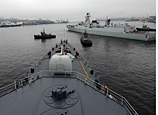
WASHINGTON, July 9 (Xinhua) -- The next U.S. rover to Mars should look for signs of past life, collect samples for possible future return to the Earth, and demonstrate technology for future human exploration of the Red Planet, a team of scientists and engineers in charge of defining the U.S. 2020 Mars mission said Tuesday.
The recommended science goals are highlighted in a 154-page document, which was submitted by the U.S. government-appointed Mars 2020 Science Definition Team after five months of work.
The report said the National Aeronautics and Space Administration (NASA) plans to re-use much of the design of Curiosity, which landed on Mars almost a year ago, to build the rover to ensure mission costs and risks are as low as possible.
It detailed how the rover would use its instruments for visual, mineralogical and chemical analysis down to microscopic scale to understand the environment around its landing site and identify biosignatures, or features in the rocks and soil that could have been formed by past life.
"The Mars 2020 mission concept does not presume that life ever existed on Mars," said Jack Mustard, chairman of the Science Definition Team and a professor at the Geological Sciences at Brown University. "However ... past Martian life seems possible, and we should begin the difficult endeavor of seeking the signs of life."
The team, which is composed of 19 scientists and engineers from universities and research organizations, is also proposing the rover collect and package as many as 31 samples of rock cores and soil for a later mission to bring back for more definitive analysis in laboratories on the Earth.
It said that a retrieval mission could occur as early as the mid-2020s or wait until the 2030s but such timing would be determined by future budget availability and the technology capabilities that are developed in the coming years.
NASA intends to send humans to Mars by the 2030s, and samples collected and analyzed by the rover will help inform future human exploration missions to Mars, the team said.
The rover could make measurements and technology demonstrations to help designers of a human expedition understand any hazards posed by Martian dust and demonstrate how to collect carbon dioxide, which could be a resource for making oxygen and rocket fuel, it said.
Improved precision landing technology that enhances the scientific value of robotic missions also will be critical for eventual human exploration on the surface, it added.
"Crafting the science and exploration goals is a crucial milestone in preparing for our next major Mars mission," said John Grunsfeld, NASA's associate administrator for science in Washington.
"The objectives determined by NASA with the input from this team will become the basis later this year for soliciting proposals to provide instruments to be part of the science payload on this exciting step in Mars exploration," Grunsfeld said.
















 Severe rainstorms batter SW China quake-hit regions | Pedestrians fall into river after bridge collapses
Severe rainstorms batter SW China quake-hit regions | Pedestrians fall into river after bridge collapses


![]()
